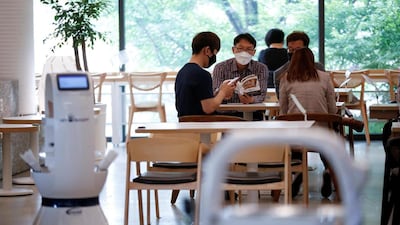It’s been more than 10 months since countries around the globe started going into lockdown to stem the spread of the Covid-19 pandemic. After intermittent openings, the second and third waves of the virus forced many countries to implement further lockdowns on their residents.
But during these challenging times, many groundbreaking innovations have been developed to address a range of issues associated with the pandemic, including the shortage of face masks and ventilators, and helping people to live safely with the virus as they wait for mass vaccinations to begin.
Here, The National shortlists nine top Covid-related inventions:
Snorkelling masks turned into ventilators
Technology firm Isinnova produced a 3D-printed adapter that converts a snorkelling mask into a ventilator – a critical device for seriously ill coronavirus patients. The Italian start-up collaborated with French sporting goods retailer Decathlon to procure snorkelling masks to develop the prototypes.
It also used the 3D technology to meet the scarcity of valves used in ventilators. Made of plastic, the valves weigh 20 grams each and connect oxygen masks to ventilators used by coronavirus patients.
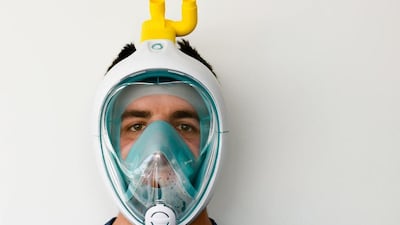
Mercedes develops alternative to ventilator
A team of Mercedes F1 engineers joined forces with the University College London to mass-produce continuous positive airway pressure (CPAP) devices, which are used to support patients with breathing difficulties.
CPAP machines work by pushing an air-oxygen mix into the mouth and nose at a continuous rate, keeping airways open and increasing the amount of oxygen entering the lungs. Invasive ventilators deliver oxygen directly into the lungs, but require heavy sedation and a tube placed down the patient's windpipe.
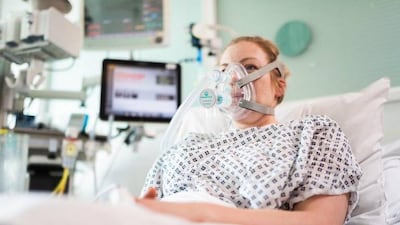
LG’s battery-run face mask
South Korea's LG Electronics rolled out a battery-powered face mask fitted with two air purifiers. The PuriCare Wearable Air Purifier mask comes with a special case that disinfects it with ultra-violet light.
Weighing only 126g, the Puricare mask can be used from four to eight hours. It is available in the UAE at select outlets of Carrefour, Sharaf DG and ACE stores for Dh699.
Immutouch wristband
The Immutouch wristband, developed by Seattle-based company Slightly Robot, uses an algorithm to interpret data from a gravity sensor that activates a buzzer if a person is about to touch their face with their hand.
The mouth, nose and eyes are all potential points where the new coronavirus can enter the body, so people can infect themselves if their hands are contaminated. Originally developed to discourage habits such as nail-biting and hair-pulling, the Immutouch has found renewed use since the coronavirus emerged.
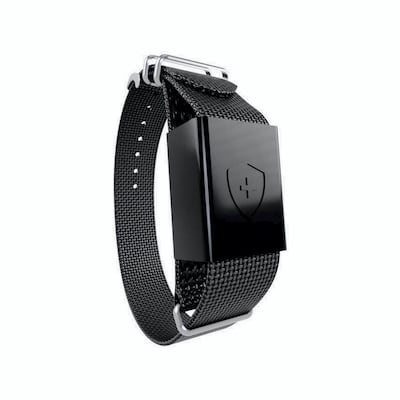
Mask with opening for eating
This special mask allows users to eat and drink even when it’s on. It comes with an eating slot that can be opened either automatically or by a hand remote.
"You open the mask for a few seconds only to put food inside the mouth… and most of the time when the person is eating, the mask is closed," Asaf Gitelis, inventor of the product and vice president of Israel-based technology firm Avtipus Patents and Inventions, told The National.
Mr Gitelis has patented the product and is exporting it to different markets in Europe and the Americas.
Robo-dog
A robotic dog called Spot is roaming around Singapore's parks, ensuring people maintain a safe distance from each other. Developed by Boston Dynamics, an American engineering and robotics design company, Spot can be controlled remotely. It is also fitted with cameras that are used to estimate how many people are visiting the park.
Lego robot to fight coronavirus
Syrian refugees at the Za’atari refugee camp in Jordan have designed a robot made from Lego blocks. It automatically dispenses sanitiser so people don’t have to touch the bottle.
“We made this robot to contribute, as refugees … we want to be part of the fight against coronavirus,” said Marwan, a Syrian refugee who trains others in robotics at the camp.
“The robot consists of simple Lego bricks, as well as the brain and the sensor. You put [out] your hand, it signals that it gave you [the] sanitiser, and that’s it,” he added.
Delivery on robo-wheels
Many companies are experimenting with robots to deliver food, medicines and other essential items to reduce the scope of human contact.
San Francisco-based start-up Starship Technologies this year rolled out its food delivery boxes on wheels in various parts of the US and the UK.
The Softbank-backed delivery app Rappi is also trying robots to reduce physical contact with its customers. It operates in Colombia, Mexico, Peru, Chile, Uruguay, Argentina and Brazil.
UV wand to fight Covid
Aircraft maker Boeing and Florida-based technology company Healthe have developed an ultraviolet wand designed to clean and disinfect the interiors of airplanes.
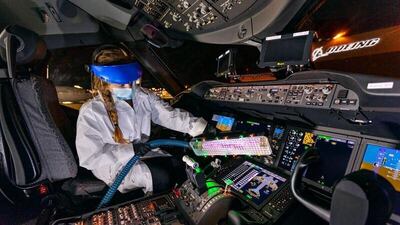
The UV wand uses a 222 nanometre UV light that, research indicates, kills pathogens effectively. Crews can pass the UV light over high-touch surfaces, sanitising everywhere the light reaches. It is particularly effective in compact spaces and can sanitise a flight deck in less than 15 minutes.
